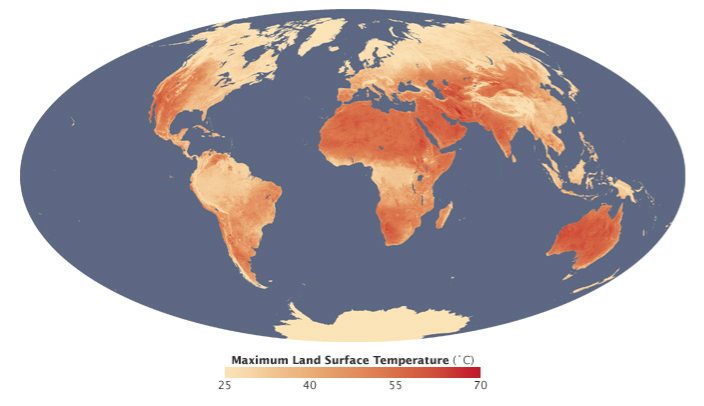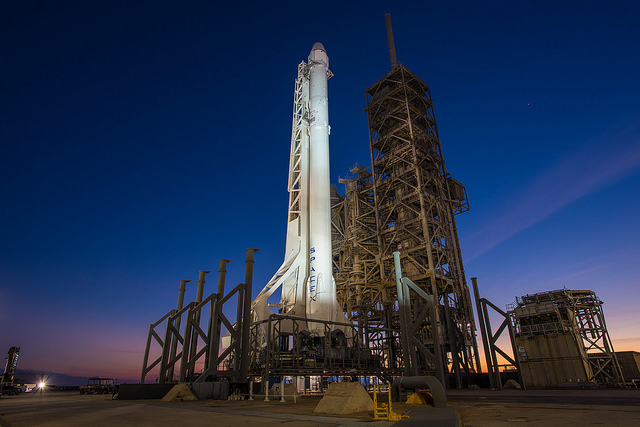SpaceX Falcon 9 on Launchpad 39A, 16 February 2017 | Photo: SpaceX, CC0 (public domain)
This week we have stories about the first launch from Kennedy Space Center’s pad 39A since 2011, a black-hole gazing telescope literally the size of the planet, and yet another team of intrepid data savers, trying to protect the future of American science. It’s the roundup for February 19, 2017!
***
39A Alive Again
On July 8, 2011, the space shuttle Atlantis launched on the final flight of the space shuttle program, and it did so from Kennedy Space Center’s Launch Complex 39, Pad A. Since that time, things have been quiet over at 39A — but no more. As of 9:39am today (EST), launchpad 39A is back in business, under a new SpaceX lease that saw its first launch liftoff this morning on a resupply flight to the International Space Station. The flight was supposed to take off yesterday, but was dramatically scrubbed less than fifteen seconds to launch due to what Elon Musk later tweeted as the a “slightly odd” “movement trace of an upper stage engine steering hydraulic piston.” Musk claims to have called off the launch personally, saying that everything “was green for launch,” but that he called it off because he thought 99% wasn’t quite high enough chance of success. It was a reassuring move from the billionaire space mogul, signaling a respect for the simple fact that (as he’s found out personally) “space is hard.” Today’s launch went off without a hitch, and will be delivering ~5500 lbs of supplies to the ISS when it arrives around 9am EST on February 22. You can read more on yesterday’s scrub at Spaceflight Now, and watch the video of the launch (if you missed it) below:
Note also that this was a fantastic daytime launch, and that Elon Musk has a great sense of humour.
@sc00bs It's much easier to do the CGI that way
— Elon Musk (@elonmusk) February 17, 2017

EHT Nears Completion
At the heart of our galaxy is a supermassive black hole with an estimated mass of 3.4-4.6 million solar masses. Well, we’re pretty sure it’s a black hole. Sagittarius A* (pronounced “A-star”) is an incredibly bright radio source near the center of the Milky Way, and the BBC is reporting this week that the planet-sized Event Horizon Telescope is gearing up to begin observations in April. The EHT is what’s called a “virtual” telescope: it takes radio telescopes in eight locations around the world — Hawaii, California, Arizona, Mexico, Chile, Spain, France, and Antarctica — and synchronizes their simultaneous observations using atomic clocks. With some sophisticated mathematics, they can together create a virtual radio telescope with the resolution of a planet-sized radio telescope. And they’re going to need it — despite its mass being millions of times that of the sun, Sagittarius A*’s even horizon is only about 12.5 million miles wide, about fourteen times wider than the sun. At 26,000 light-years away, we’re going to need the best resolution we can get. The EHT is on track to start observations of the (suspected) black hole on April 5. You can read more about the EHT and Sagittarius A* at the BBC, over at the Event Horizon Telescope’s page, and at their Scientific American-hosted outreach blog Dark Star Diaries.

Coders Saving More Data
Even before Trump took office, coders and other volunteers from around the world were downloading and saving publicly available datasets from American governmental sources, and one month into the most anti-science presidency in American history the efforts continue. Wired reported that last week volunteers gathered on the campus of UC Berkeley to scour NASA’s idiosyncratic network of public-facing websites and servers for data worth backing up — specifically the Earth sciences programs, which are very likely to be scaled back, dismantled, or defunded. One Trump plan calls for the elimination of Earth sciences from NASA’s mandate in favour of shifting that over to NOAA — but with no additional funding on offer for NOAA to do the work of gathering climate data, and no satellite-building experience at the latter agency, it seems to be the cancelling of climate science by any other name. But the challenge faced by the data-savers isn’t small: according to one member of the Berkeley “bagger group” (taggers and baggers are responsible for flagging and downloading data, respectively), the NASA sites were all “written piecemeal over the course of 30 years. There’s no coherent philosophy to providing data on these websites.” Getting access to the data isn’t often simple, not because its hidden, but because it’s not well organized. Nevertheless, the hard work of the volunteers could be vital to the continuation of US climate science going forward, and so we should all be grateful for their hard work. As the saying (sort-of) goes, the lives they save could be our own. You can read more about the data-saving movement at Wired.
ICYMI
Here’s what we got up to this week — if you missed any of it, now’s your chance to catch up!
- On Monday, I praised Republicans for a plan to deal with Climate Change — because it meant they weren’t denying it
- On Tuesday, I explained that there are ways of checking those “asteroid armageddon” Daily Fail stories
- On Wednesday, Prudence talked cow farts and sustainability
- On Thursday, I talked about DDT, Rachel Carson, and science-based policy, and
- On Friday, Elle tried her hand at a little satire, as a way of dealing with the complete insanity here in America
Go check ’em out!
Best of the Rest
Of course there’s always more going on than we can cover each week here at This Week In Tomorrow, so, as usual, here’s your weekly linkspam:
- The patent for CRISPR-Cas9 went to MIT’s Broad Institute, though the battle isn’t over
- India launched 104 satellites from a single rocket
- A man trashed his Tesla to save another driver (don’t worry, Musk’s paying for the repairs)
- Mark Zuckerberg wrote a 6,000-word letter on, well, a lot of things
- Trump’s pick for science adviser is a climate-change denier who calls 97% of climate scientists members of a “cult”, and
- Philip Pullman has announced release dates for another trilogy set in the same world as His Dark Materials (Can’t. Wait.)
That’s all for today. Have a great week.
***
Thanks again for reading. Except for the very *very* occasional tip, we only get paid in my own (and your) enthusiasm, so please like This Week In Tomorrow on Facebook, follow us on Twitter @TWITomorrow, and tell your friends about the site!
If you like our posts and want to support our site, please share it with others, on Facebook, Twitter, Reddit — anywhere you think people might want to read what we’ve written. If there’s something you think we’ve missed or a story you’d like to see covered, drop us a line! Thanks so much for reading, and have a great week.
***
Richard Ford Burley is a human, writer, and doctoral candidate at Boston College, as well as Deputy Managing Editor at Ledger, the first academic journal devoted to Bitcoin and other cryptocurrencies. In his spare time he writes about science, skepticism, feminism, and futurism here at This Week In Tomorrow.

